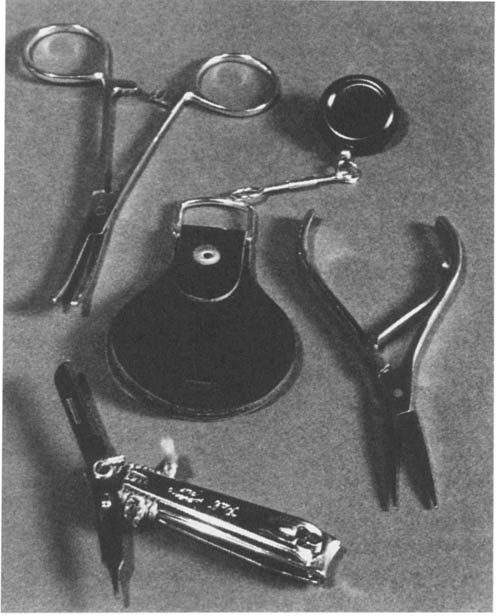
Many people jokingly have said that the great draw of fly fishing is not necessarily the method itself but all the tools and gadgets that go along with the sport. I, for one, can’t deny this, for the sport does have a seemingly endless array of paraphernalia that, sad to say, we seem not to be able to live without. Each year manufacturers both large and small dream up new and helpful items. Although none is absolutely required for catching fish, most add to the convenience of our time spent on the streams. The following is a discussion of those items that can aid any fisherman.
For consolidating and organizing the immense number of items that we use, the fishing vest is certainly the most convenient container of all. Vests come in many designs and price ranges. Most have a seemingly staggering number of pockets, each of which is fashioned to fit one of the various types of fly boxes, bottles, and miscellaneous packages that the fisherman carries to a stream. Both regular and short lengths are available, with the latter being very popular for wading in deep water. Regardless of your choice of design, it is important to acquire one that fits your needs and will withstand many years of use, for a fishing vest is an essential item for fly fishermen.
Each tool that goes into or attaches on a vest is designed for specific functions, and there will be times when you will need all the accessories.
As far as I am concerned, a pair of sharp scissors is the most important cutting tool you can carry. It is useful not only for cutting leader but also for trimming and reshaping flies.
Today many trout streams have barbless-hook regulations, and, because many purchased flies do not come barbless, a good pair of small needlenose pliers is needed for flattening the barb. In purchasing pliers, make sure the inside jaws are flat and smooth, not serrated.
Surgical forceps, or hemostats, are essential for disengaging a fly from the fish’s mouth. Available in both curved and straight tips, they protect the fly from being mangled by fingers, and, with their locking feature, they can be hung from a vest pocket flap for easy accessibility.
Clippers have long been used to trim and cut excess leader materials. Although a useful and inexpensive item, their disadvantage is that they are often not sharp enough for every task, which can make them ineffective for trimming and reshaping flies. If a pair of good scissors is not available, nail clippers of one type or another are your best bet.
Retrievits, or pin-on reels, are a convenient way of holding the various tools. The retractable cord attached to the vest keeps the tools, when not in use, conveniently close. A very handy item.
I am not a great fan of leader straighteners, if for no other reason than that they are generally used improperly. Most contain a rubber backing, which, when the leader is pulled through, will straighten out its memory coils. Unfortunately, the rubber can build up heat friction, which weakens the leaders. If you do use a straightener, be sure to wet it before you strip the leader through it.
Accessories
Your don’t necessarily need every accessory shown here, but each can be handy in a pinch.
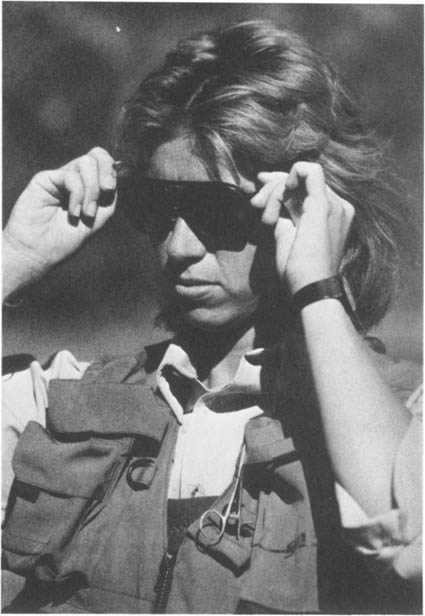
Sunglasses
A good pair of polarized sunglasses are essential to the fly fisherman. Not only do they protect the eyes from stray flies, their polarization cuts glare, enabling a better view of both fly and fish.
Since fly fishermen need to carry tippet material of different diameters, I recommend a dispenser to organize the tippet spools. Dispensers are fashioned so that the tippet of the appropriate size can be quickly located and individual spools do not unravel in your vest pocket. Although not essential, they are convenient.
Polarized sunglasses are the most important single accessory a fisherman should possess. They not only cut the glare off the water, enabling you to see both fly and fish, they protect the eyes from a stray cast of the deadly barbed hook. Years ago, because of the nature of polarization in sunglasses, many were made of soft plastics, which had a tendency both to distort vision and to scratch easily. But today’s hard plastics have made polarized glasses durable and optically correct at nominal prices. Get the best you can afford. Your eyes will love you.
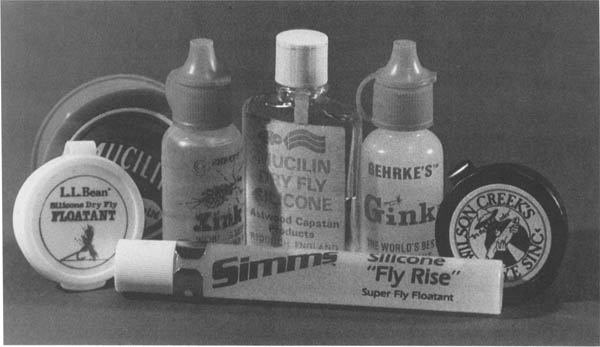
Smart anglers always carry special sprays and pastes to: 1) help dry flies stay afloat, 2) help leaders sink.
If you intend to fish a dry fly, a silicon-based dry fly spray or paste-type ointment will help keep the fly floating. The paste type lasts a bit longer on the fly than do the sprays. In purchasing dry fly ointments, look for those that are colorless and odorless.
Relatively new on the market, dry fly powders have replaced the once-popular Amadu fungus for cleaning and drying a dry fly. Dry fly powders remove mucous that the fly picks up from the fish’s mouth, and, because they have a silicon base, will contribute to fly flotation as well.
Although not essential, leader sinks aid in breaking the surface film, allowing the leader to drift below surface, where it is best disguised. Fishermen once used Lava soap and mud from the streambank to accomplish this task, but today, the various commercial leader sink dressings are both convenient and effective.
Regardless of where you fish, various kinds of biting insects are likely to be present. A good insect repellent is therefore essential. When using and applying repellent, it is important to keep your hands clean of it, as the various chemicals used can be destructive of fly lines and rod finishes, and the petrol odors are detectable to fish.
A complete fisherman should carry an assortment of flies, and these important items need to be conveniently stored for easy accessibility and selection. Fly boxes thus become part of the basic gear of a fly fisherman. Boxes come in a variety of sizes, shapes, styles, and materials and are designed not only to store sufficient quantities of imitations but to fit in the various pockets of our vests.
Unbreakable plastic boxes are the most popular type of fly container available today. Inexpensive and very rugged, they come in compartment configurations designed for the various imitations you may use. If there is one disadvantage to the compartment box, it’s that the actual fly selection and identification can be difficult, especially if many flies are carried. Plastic boxes with foam inserts to which the fly hook can be firmly attached facilitate better organization and easier recognition.
Metal boxes have been around for many years and are still a convenient way to carry your flies. Some come with clips designed primarily for wet flies and nymphs; others have coil springs into which the hook is inserted; still others have individual compartments with small windows so that you can see the fly but it cannot fall out. Metal boxes are generally heavy and, I have found, do have a tendency to rust hooks, especially after the box has taken the inevitable dunking in the stream. Window-type containers also have a tendency to pop open when the box itself has been unlatched.
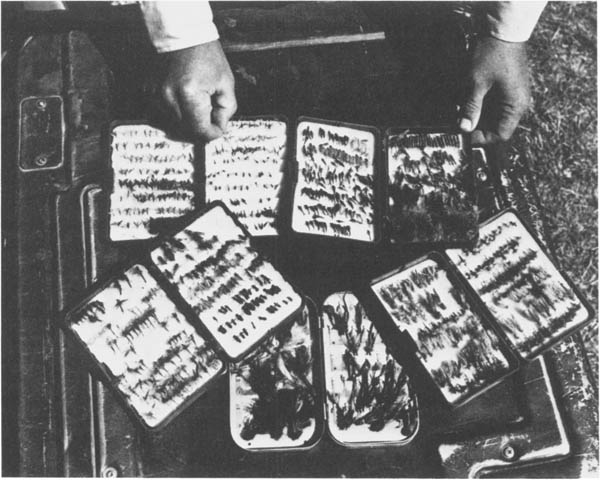
Fly-box designs, styles, and functions are numerous. Some come with various compartments, others with foam or magnetic pads, in materials ranging from metal to plastic. Here, the author’s fly boxes: one for each stream and pattern type, with foam pads for easy inventory.
Zippered fly books are primarily used for wet flies and streamers. Generally constructed of leather with a shearling fleece lining to which the flies are attached, they are a reliable way to store the often-valuable flies.
Although fleece patches come standard on vests and are convenient for storing flies, I do not recommend their use. In general, they lose more flies than they store. I often refer to them as “the fly retailer’s dream,” because they guarantee that the fisherman will return to the store to replace those flies he lost using these “conveniences.”
Because leaders come in a variety of lengths and sizes, leader wallets are helpful for storing and sorting the assortment of fly leaders that we must carry. They fit nicely into vest pockets, and I highly recommend them for overall storage.
Next to rod, reel, and line, wading gear is perhaps the costliest—but at the same time the most important—piece of equipment you will buy. As a small boy, I waded the streams wet, with only tennis shoes and long pants. It was not until I donned my first pair of waders that I realized the comfort I had been missing.
Waders have come a long way in the past years, but still no one manufacturer has made the perfect, indestructible product. All waders will rip on a barbed-wire fence but, mirabile dictu, most are easily repaired. Because they need to be water-impermeable and are designed to fit the average fisherman (and many question what that is), wading gear can be excessively hot and not necessarily form-fitting. Regardless of these faults, it does keep us dry and protect us from the bone-chilling cold of many trout waters, making it an essential item.
Waders come in a variety of styles and materials, all of which have their advantages and disadvantages. Let’s take a look at some of the basic types.
For years, the hip boot and full chest wader have been the most popular type of wading gear used by fishermen. Manufactured as a single unit, with the boot attached to the upper wader, hip and chest waders are designed not only to protect you from the elements but also for convenient donning and removal. The hip boot, which rises to about crotch level, is used for fishing small streams and wading in waters that are not deep. The chest-high type, extending to the chest or armpits, is for wading deeper water, and overall is the most utilized style.
As popular as these two types of waders are, they do have their disadvantages. Because they are designed for the average body size, they have a tendency to be either baggy or tight-fitting, especially respective to the leg length, or rise. The latter, although not a problem with hip boots, can be quite uncomfortable in the chest-high type. Also, because the shoe portion of the wader is constructed of rubber and is oversized, it does not offer good support for general walking and wading freestone streams.
For years stockingfoot waders were used primarily by those fishermen who ventured into fast, heavy-water streams, for they offered greater support than did the boot-foot type. Today their popularity, especially among fly fishermen, has surpassed the traditional type wader because of function, wading support, overall utility, and longevity. They come in a wide variety of materials that are lightweight, flexible, and warm.
The stockingfoot is a full chest wader, but instead of having a rubber boot attached it relies on a leather or synthetic wading shoe placed over the foot portion: hence their descriptive name. Most stockingfoot waders are made of latex rubber or a coated nylon material, either of which is very serviceable for fishing. In addition, neoprene rubber waders have more recently become very popular. The material offers tremendous flexibility and uniform insulating value resulting in protection from bone-chilling waters. Too, because it seals against the outside temperature on hot days, the neoprene will not allow you to get any warmer than your normal body temperature.
Placed over the stockingfoot wader is a wading shoe, which today comes in a variety of styles and materials designed to give you support for walking. Years ago most wading shoes were made of leather, but today many are synthetic imitations of leather, which can withstand watery situations without rotting. Some are nothing more than an advanced copy of a high top tennis shoe with a hard sole and toe to protect the feet from sharp rocks. Others resemble a working boot that offers good ankle support and added protection. Because most fall roughly in the same price range, I suggest the latter, full-lace type.
Gravel and small rocks are always a problem with stockingfoot waders, and many fishermen purchase various types of gravel guards. Wrapped around the top portion of the wading shoe, they keep the small annoyances from trickling down against the feet and ankles. No matter which type of stocking-foot wader you choose, be sure to include a pair of gravel guards with them.
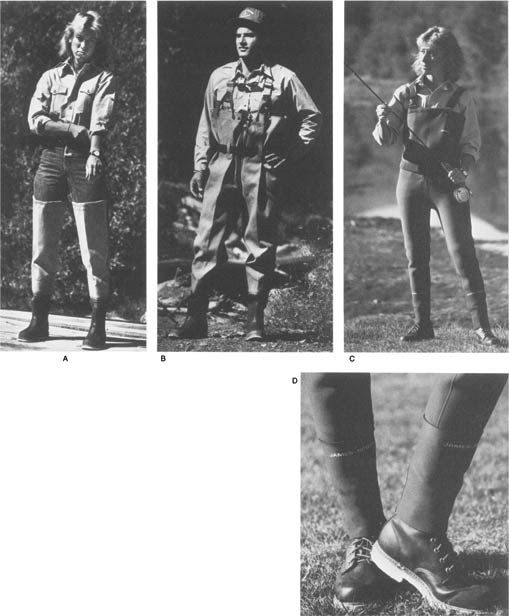
For shallow-stream wading, hip boots (A) may do the job, but chest waders (B) and neoprene stocking-foot waders (C), are more versatile. Top your stocking-foot waders with a pair of felt-soled wading boots and gravel guards (D), and with any wader, follow the example of these anglers: wear a belt.
Whether you choose boot or stockingfoot waders, it is imperative that the waders and wading shoes have felt soles to help prevent slippage on rocks. Sometimes even more traction is desirable. Wading cleats, with aluminum grid bars in various configurations, attached to the bottom of the boot or wading shoe, counter the most slippery conditions. The most popular are the galoshes-type that slip over the boot. Some manufacturers also offer a sandal-type cleat with protruding spikes, useful where the rock is very porous. For the common, rounded river rocks, the grid-bar design seems to work best.
There are always a few items that may not be essential but do add to the convenience and comfort of fishing. Some of them, I think, should be at least considered by the well-prepared angler.
Regardless of where you wade, long underwear can make the experience more comfortable. If you do a great deal of fishing, you must keep your legs as warm as possible, for over the years the cold water will take its toll on your circulation. A good set of underwear, made from either a combination of wool and cotton or one of the new polypropylene materials that wick moisture away from the skin, will do the job nicely. To help avoid crippling leg pain in later in life, wear long underwear.
Adequate raingear is one of the more important things a fisherman can carry, for you never know when a sudden rainstorm will appear. Raingear comes in a variety of materials, from rubberized nylon to synthetic-coated stock. Rubberized nylon, although it does not offer “breathability,” still works the best. It protects you not only from a quick shower, but also from a day-long rain, which eventually will penetrate any other types of materials. Because it lacks breathability, inside condensation does occur and can make things rather clammy if you have to wear it for a long time. The new synthetic materials, with their “breathability” that allows water vapor to escape through the fabric, have taken the outdoors world by storm, but you should recognize the difference between these highly water-resistant materials and those that are waterproof. Although breathable, water-resistant synthetics work for most rainy conditions, a torrential all-day rain will eventually cause them to absorb water and leak.
When you purchase raingear, make sure that the seams are stitched, that zippers are rugged, and that the material will withstand years of punishment. Workmanship is important. And remember, raingear belongs with the fisherman, in his vest, while fishing; it does not belong in the car or at the house, where it will do absolutely no good in the event of a quick downpour. Also, even if rain is not imminent, it may come in handy as a windbreak if the weather turns chilly.
There is a full range of products available for carrying gear and personal items on a trip or to the stream. Medium and large duffels are nice because they can carry all your wading gear, vests, nets, and so forth, in addition to your clothing. A small kit or shoulder bag for carrying the essential equipment that won’t fit in vests (such as reels, extra spools and fly boxes, wading patch kits and other accessories) also has its place.
Rod bags are not essential but they keep all your rods conveniently together in one place and prevent them from banging around in the back seat of a car. A bag and crushproof metal carrying tube are, however, absolutely essential for transporting each of your rods on long trips.